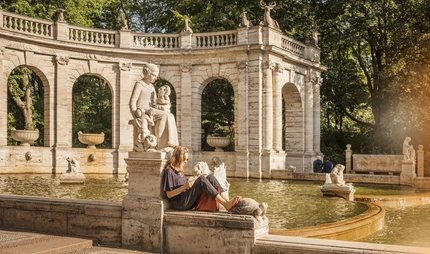
Luisenstädtischer Kanal
So many broken dreams
The water sparkles in the great Engelbecken at St. Michael’s Church. A fairy-tale Indian fountain splashes. Take a walk along the former canal.
Despite its name, Luisenstädtischer Kanal is not a waterway anymore. Instead, it's a place for nostalgic dreams where you can stroll through the wonderful gardens from Mitte to Kreuzberg.
A relict of past times
The Engelbecken (Angel’s Pool) is the only visible reminder of the historical Luisenstadt canal. Restored in 1999, the pool, with its numerous fountains, stretches out in front of St. Michael’s Church. Time flies by when you gaze at the glittering water on a peaceful afternoon. The man-made waterway between the river Spree and Urbanhafen took a detour from its straight route to meet the Engelbecken. Today, the drained canal bed is a park and gardens.
Construction of the Luisenstädtischer Kanal
In 1825, the idea was first mooted of building a waterway through Luisenstadt, at that time a suburb of Berlin. Fifteen years later, the King of Prussia commissioned the town planner Lenné to design a connection to reduce the traffic on the river Spree. The real reason for the construction project, however, was to occupy the city’s many unemployed. Work began on the 2-kilometre-long canal between the Landwehrkanal and the Spree in 1848. Four turbulent years later, the project was completed and the first ship passed through the new waterway, which led straight to St. Michael’s Church, and turned just before it into the Engelbecken.
The canal is filled in again
Due to the noise, the stink and the lack of shipping traffic, the decision was taken in 1926 to fill in the Luisenstädtischer Kanal, except for the Engelbecken, which survived as a central square. The landscape architect Erwin Barth argued for the canal to be kept, but the city government could not be persuaded, so he then developed ideas on how the park could be designed. One of his plans was to bring a romantic, Indian atmosphere to Berlin, but the church opposed this. The next draft included a park with a swimming pool, a playground and a small Indian garden. Here too, Barth was soon disappointed, because there was not enough money for it. A few of Barth’s ideas were finally implemented after 1926, and rebuilt in the 1990s after the destruction of the Second World War.
A stroll along the old canal
The best way to explore the garden is to take a walk. The route runs from the Schillingbrücke on the Spree and then along Engeldamm, Leuschnerdamm, Legiendamm and Erkelenzdamm to the Urbanhafen on the Landwehrkanal.



